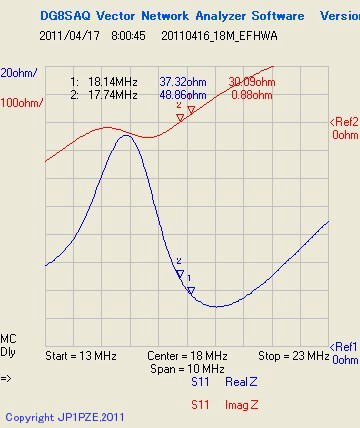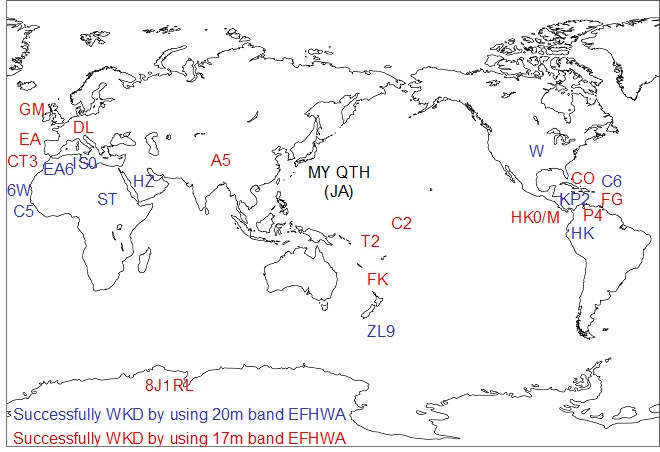EFHWA(End Fed Half Wave Antenna)
EFHWA is a kind of antenna that is feeded from the end of an half wave element, not like as dipole. Therefore, no center support is required. I am using EFHWA as a non-radial vertical antenna on field operation. What required to install the antenna, is only put antenna element to along glassfiber pole. It is very easy and convenience.
At the end of half wave antenna element, calculated impedance is becoming very high (ideally, it is indefinite!), and you could not to connect coaxial cable directly to EFHWA. So, matching circuit is required to step up impedance.
Some kind of matching circuits are used among amateur radio community, I am using LC network to get high impedance output. The circuit is shown on Fig.1.
On this circuit, if ωL=1/ωC and Zin<ωL,
Then, Zin x Zout≒ωLx(1/ωC).
Therefore, Zout=ωLx(1/ωC)/Zin
On my EFHWA, I set ωL at around 500Ω, and as results, Zout would be 5KΩ.


Fig. 2 impedance characteristic versus frequency on 17m band EFHWA
Figure2. shows impedance characteristic versus frequency at feed point of the 17m band EFHWA I made. This characteristic is measured by using network analyzer “VNWA2.” The blue line shows resistance and red shows reactance. S curve of blue line is very impressive. The measurement results shows that matching circuit does not resonant at 17m band exactly, you can see that R shows around 50Ω and X=0 at 17.7Mhz. I have also measured SWR by using SWR analyzer and get good SWR at 17.7Mhz sure. But practically, no problem occurred for use.
I usually operate from bank of river my neighbor. Good lookout gives good propagation. With the EFHWA, I worked with west Africa and Caribbean stations which making contact is difficult for JA.
For the coil of mathing circuit, I use 2sq wire and 38mm diameter glassfiber pipe for coil bobbin, and use 75Ω coaxial cable for capacitor. Regarding power, running at 50W is no problem. Perhaps, it is OK even though 100W.
To pursue performance, PE insulated wire is used for the coil and the antenna element. PVC, widely used for insulator has no good RF characteristics. At first, I used PVC insulated wire for the coil and the antenna element. But, when I changed antenna element from PVC insulated to PE insulated, I realized receiver sensitivity has been improved clearly. Since PE has low εr than PVC, you need more longer element.
Entities I made contacts with the homebrew EFHWA
